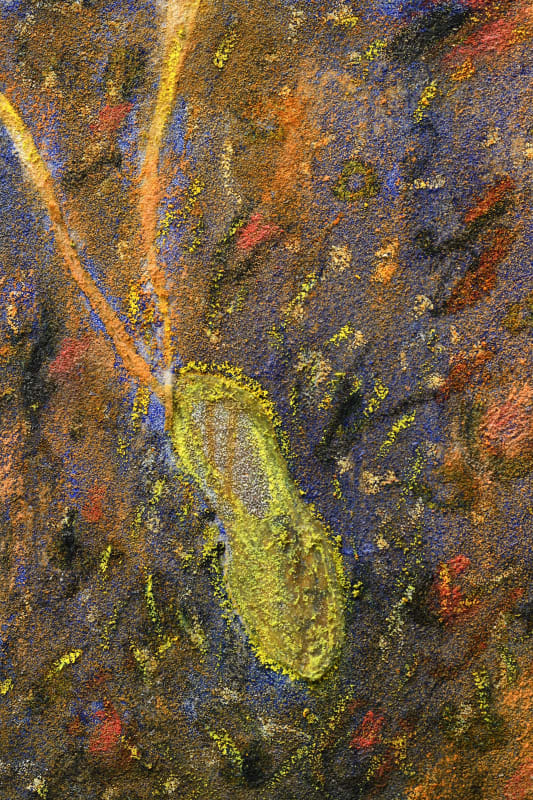BY EL BITTENCOURT
In Calzolari’s recent paintings, organic and metaphysical forces are one: vapors are rudimentary atmospheric gas particles, but they also signify wonder and bliss.
The Italian artist Pier Paolo Calzolari is a breezy alchemist of color, as evidenced in Painting as a Butterfly, his fourth show at Marianne Boesky Gallery. If painting is a butterfly, it must exert a delicate sensorial pressure with its formal “flutter.” Such is the effect of some 30 paintings by Calzolari, most of them made in the past five years, with three dating back to the 1970s and ’80s. Calzolari frequently layers the new works with salt crystals. He then applies pastels, gouache, or tempera to the canvas; the effect is that the pigments are absorbed unevenly, producing dense blotches, but also areas where color dilutes and sinks, or washes out entirely. The resulting tensions — between permanence and evanescence, expressed in, for example, tempera’s opaque solidity versus the salt’s flickery luster — lie at the core Calzolari’s alchemy.
Born in Bologna in 1943, Calzolari is one of the few living artists associated with Italy’s arte povera, a movement that sprung up in the 1960s to oppose a minimalist aesthetic coopted by capitalist, consumerist society. In addition to the arte povera artists’ preference for organic and homespun materials, their artworks often flirt with figuration, and specifically with the suggestion of the human form in Calzolari’s current work. Consider the works in the gallery’s intimate back room: disarmingly prosaic footprints waltz across a few small canvases hung salon style. Rendered in chartreuse, the shoe bewitches — a Cinderella with rash dreams of fluid identities. (A similar romantic adventure emanates from “Untitled,” 2019, in which a gauzy dress hovers atop a summery abstraction.) Calzolari’s grayish-brown version of the shoe, however, is closer to Van Gogh’s somber take: a peasant’s famously worn and weary pair, whose lyricism is scrappy and earthbound.
Calzolari’s magic can also be cosmic, as in a small painting in the same gallery, in which a tailed circle tumbles in the lower left like a frightened comet. In all these pieces, organic and metaphysical forces are one: vapors are rudimentary atmospheric gas particles, but they also signify wonder and bliss. Yet, if there’s more than a bit of razzle dazzle and overall shimmy here, it’s not without resistance — the surfaces are often pumice-like, taking their cue from the multifarious properties of salt, both dissoluble and obdurately rock hard.
It’s nearly impossible to view Calzolari’s paintings without also recalling the masterly vigor of Italian Renaissance artists. The artist gestures toward this explicitly in “Venetian Painting” (2019), in which the lush ultramarine so beloved by Titian and his posse is a hovering, dense nebula, or maybe a Romanesque-arch-like portal to hidden mysteries — while the rest of the composition blanches under canary streaks like a mirage glimpsed across the piazza through rain-streaked windows. Elsewhere Calzolari conjures up an even more elusive chemistry, as in most paintings whose titles or forms refer to haikus: an evocation of nature so grounded in the elemental that for a second only the salt seems to exist. It breathes into the canvas pores, excreting its hermetic residue, like a genie conjured from an alchemist’s flask.


